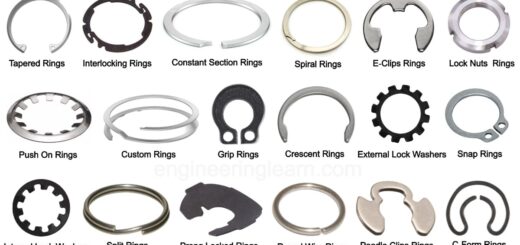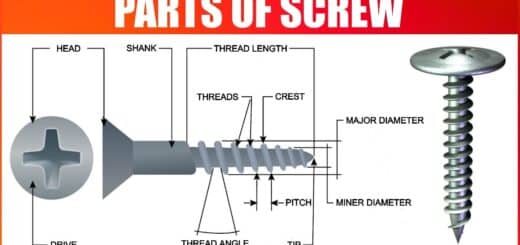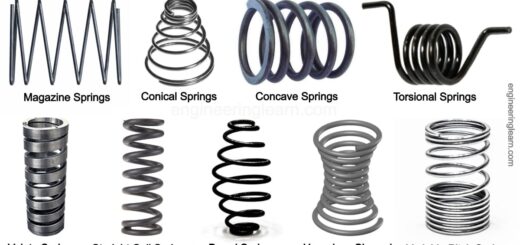Flange Protectors – Introduction, Types, Uses, Needs & Advantages [Complete Guide]
![Flange Protectors - Introduction, Types, Uses, Needs & Advantages [Complete Guide]](https://engineeringlearn.com/wp-content/uploads/2023/01/Flange-Protectors-1024x539.jpg)
Introduction
Flange Protectors – Introduction, Types, Uses, Needs & Advantages [Complete Guide]: – Over the past few years, piping design has really taken off in this country which has brought our focus to the various components associated with piping design. Flanged joints have been used in joining large cylindrical pipes for the longest time now and it is only imperative that they now be studied in greater depth.
Flange protectors protect the flange studs, face, and gaskets on the raised face from atmospheric corrosion as encountered in many applications. Applications include offshore oil fields, onshore oil fields, refineries, gas stations, fuel pumping stations, etc. The above-mentioned applications are all those places where the flange section faces a considerable amount of moisture content or foreign particles produced from some other source that just might affect the overall performance of the flanged joint.
This is important because corrosion resistance of such high-performance machine parts needs to be taken seriously and there can be severe consequences of ignoring these effects. The damaging effects of corrosion on these flanged joints need to be taken into account for better designing of these machine parts. These factors play a major role in piping design and the overall maintenance of the pipes and their associated machine components.
Why Need for Flange Protectors?
Flange protectors act as a protective covering over the face of the flange that acts as a shield against corrosion that might lead to several problems like pipe leakage, loss of required pressure needed to continue the fluid flow, excessive localized pressure at some point due to unbalanced forces acting on the flange part. These problems, if gone out of hand, can lead to a total shutdown of the machine part that can incur high costs when operated in an industrial setup like an offshore drilling setup.
The costs of such a shutdown can be too high to not give due attention to the flange’s operational readiness beforehand. Other costs like breakdown costs, tool replacement costs of flange nuts, bolts, and seals can also lead to the bloating of bills that need to be controlled significantly.
Types of Flange Protectors
There can be many types of flange protectors that are currently in use in the industry. They can be decided on the basis of certain operational requirements that the specific task requires. There are certain specific dimensions of flange protectors that have been standardized by ASME (The American Society of Mechanical Engineers). These specifications include the width, thickness of the flange protector, inside diameter, etc.
1. Stud Hole Fitting Flange Protectors
They provide covering to the flange over the fittings made by stud holes that provide better grip and flexibility. Stud holes are made by the hole-making machines or by tap and dies and then the flange covering is transitioned into them for better rigidity.
2. Foam Flange Protector
The outer covering of the flange cover is covered by foam that provides high-temperature resistance to the flange covering apart from moisture control. Foam provides an extra layer of insulation to the flange part and thus helps in promoting better surface covering.
3. Face Plug Flange Protector
The face covers are connected using plugs that go into the flange coupling surface. Plug holes get into the groove using transition fit and the flange protectors are connected with the piping design.
4. High-pressure Flange Cover
These types of flanges covers are specifically designed to protect flanges that operate at higher pressure, typically laong the pressure range of 40-120 psi (pounds per square inch). These high pressure operations come with different set if challenges that can be tackled only by a high pressure flange cover. High pressure situations tend to promote more moisture due to high relative humidity and it becomes imperative to tackle such situations.
5. Push in Flange Cover
They have been designed to adjust to different diameters which can increase their effectiveness in dealing with different pipe sizes. They can slide into pipes of varying diameters with relative ease.
6. Full Face Flange Cover
Such types of flange covers take over the entire surface area of the pipe diameter and protect the flanged coupling from moisture and corrosion. The entire surface being covered by the flange cover gives superior protection as compared to other types of flange covers.
7. Bolted Quick Fit Flange Cover
These types of flanges are joined with the base plate and the pipe surface using bolts and nuts.
Every flange protector is equipped with a positive relief vent and plug for easy removal of the disjointed flange from its pipe clippings. Modern-day flange protectors have poly-vinyl transparent coverings that allow preliminary inspection to be done with the naked eye and filling of the joint fluid from outside. Additionally, the non-corrosive nature of the poly-band makes the service life longer than what it was before it. This increases the life of the machine part which can be of immense help in meeting several operational requirements.
Advantages of Flange Protectors
- Provides a blanket cover to the flange and its internals from the outside atmosphere
- Maintains the operational readiness of the gasket and internal seals
- Keeps out saltwater, debris, moisture, etc
- They ensure cathodic isolation protection that keeps foreign particles out of the ambit of the flange protectors. This is a very important advantage that promotes the better usability of a flange cover for industrial purposes.
- Quickly installed with a screwdriver. The replacement run time is quite less than what is achieved in other types of pipe coverings.
- Available for all flange sizes.
- Custom engineered designs available per every application. This can save significant costs of remolding and repackaging the flange covers for one application when used with some other specific application.
- The interchangeability of flange protectors is a big advantage when it comes to its operational readiness of it.
- Highly cost-effective for repeated use in an offshore/onshore drilling site.
- Can be removed and reused easily. This can mean that the overall replacement time and costs are very low for flange protectors. This adds up to the long list of prominent advantages of using them.
Challenges While Using Flange Protectors
The annular gap between the flange outer diameter is highly undesirable and is quite vulnerable to debris and foreign article including moisture. This can lead to excessive wear and tear of the gasket apart from corrosion. When operating in high moisture areas or places where high rainfall can be a possibility, the readiness of a flange protector comes as an advantage. The parts can be changed quickly which reduces the replacement downtime considerably.
Many times the flange gaskets are filled with corrosion-resistive grease that acts as a barrier between the moisture and the flange gasket. Flange protectors can be used in pressure vessels, piping connections, process plants, etc. Its application in several other cases is subject to several other factors but one thing about the flange protectors that remains constant with whichever application it is employed in is its ability to mold itself with time and give out the best possible performance for which it has been designed.
Over its many years in the industry and otherwise, it has performed up to the desired levels and has never given any scope for doubt over its operational effectiveness. The ability to protect the flange coupling from moisture and foreign particles has always been associated with the flange protectors and that has ensured better productivity.













